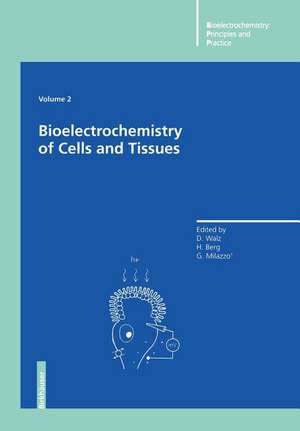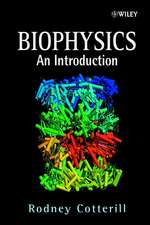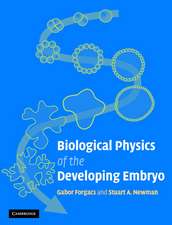Bioelectrochemistry of Cells and Tissues: Bioelectrochemistry: Principles and Practice, cartea 2
Editat de Dieter Walz, Hermann Berg, Giulio Milazzoen Limba Engleză Paperback – 30 sep 2011
Preț: 644.18 lei
Preț vechi: 757.85 lei
-15% Nou
Puncte Express: 966
Preț estimativ în valută:
123.26€ • 128.45$ • 102.06£
123.26€ • 128.45$ • 102.06£
Carte tipărită la comandă
Livrare economică 03-17 aprilie
Preluare comenzi: 021 569.72.76
Specificații
ISBN-13: 9783034898904
ISBN-10: 3034898908
Pagini: 328
Ilustrații: 305 p.
Dimensiuni: 170 x 244 x 17 mm
Greutate: 0.52 kg
Ediția:Softcover reprint of the original 1st ed. 1995
Editura: Birkhäuser Basel
Colecția Birkhäuser
Seria Bioelectrochemistry: Principles and Practice
Locul publicării:Basel, Switzerland
ISBN-10: 3034898908
Pagini: 328
Ilustrații: 305 p.
Dimensiuni: 170 x 244 x 17 mm
Greutate: 0.52 kg
Ediția:Softcover reprint of the original 1st ed. 1995
Editura: Birkhäuser Basel
Colecția Birkhäuser
Seria Bioelectrochemistry: Principles and Practice
Locul publicării:Basel, Switzerland
Public țintă
ResearchCuprins
1. Electric organs and their innervation: A model system for the study of cholinergic function.- • Introduction.- • Anatomy and embryology of the electromotor system.- • Electrophysiology of the electromotor system.- • Electrolocation and electrocommunication.- • The cellular and molecular biology of cholinergic synapses as deduced from work on the electromotor system.- • Summary.- 2. Contractility and motility of muscle and non-muscle cells.- • Introduction.- • Histology of striated muscle cells.- • Muscle physiology.- • The sliding filament model.- • Actin and myosin are proteins organized in filaments.- • Actin and myosin exist in a number of variants.- • The atomic structures of actin and myosin subfragment 1 have been solved.- • The cross-bridge cycle.- • The mechanism of ATP-hydrolysis by myosin and acto-myosin.- • Where in the myosin molecule is the force produced?.- • The regulation of muscle activity.- • Electrochemical coupling in muscle cells.- • Muscle diseases (Myopathies).- • Motor systems in non-muscle cells.- • Summary.- 3. Light-transduction in photoreceptors.- • Introduction.- • Structure and function of photoreceptors.- • Molecular basis of phototransduction.- • Light-induced currents.- • Function of calcium ions in photoreception.- • Voltage-gated currents and their physiological significance.- • Ion transport.- • Summary and conclusions.- 4. An electrochemical description of metabolism.- • Introduction.- • Cellular structure and enzyme organisation.- • Cellular energy transduction.- • Proton and electron flow in intracellular structures.- • Importance of electrical processes in the control of metabolism.- • Significance of cellular potentials.- • Theoretical considerations.- •Relevant experimental studies.- • Electrochemical regulation of metabolism.- 5. The low-frequency dielectric properties of biological cells.- • Introduction.- • Theory of the dielectric experiment.- • Mechanisms of dielectric dispersion in biological systems.- • Mechanisms of dielectric relaxation in cell suspensions and tissues.- • Nonlinear interactions of cells with electrical fields.- • A four state enzyme capable of harvesting electrical energy for the performance of useful (bio)chemical work.- 6. Dielectrophoretic and electrorotation behaviour of cells: Theory and experiment.- • Introduction.- • Theoretical background.- • Cell dielectrophoresis.- • Cell electrorotation.- • Relationship between dielectrophoresis and electrorotation.- 7. Effects of magnetic fields on living systems.- • Introduction.- • Field types and modes of action.- • Experimental in vitro results.- • Experimental in vivo results.- 8. Low-frequency electromagnetic field effects on cell metabolism.- • Introduction.- • Experimental techniques.- • Biochemical and biological response of biological systems.- • Current models for mechanisms of electrostimulation.

















